
RESEARC H Open Access
Quality of life of children and their caregivers
during an AOM episode: development and use of
a telephone questionnaire
Eve Dubé
1,2,3*
, Philippe De Wals
1,2,3
, Manale Ouakki
1,2
Abstract
Background: The negative consequences of acute otitis media (AOM) on the quality of life (QOL) of children and
their families need to be measured to assess benefits of preventive interventions.
Methods: A new questionnaire was specifically designed for use in telephone surveys. A random sample of
Canadian families was selected using random-digit dialling. Caregivers of children 6-59 months of age who
experienced at least one AOM episode during the last 12 months were interviewed. Multidimensional severity and
global QOL scores were measured both for affected children and their caregivers. Internal consistency of scores
was assessed using standard tests.
Results: Of the 502 eligible caregivers who completed the survey, 161 (32%) reported at least one AOM episode
during the last 12 months and these cases were included in the analysis. Average severity was 2.6 for children and
2.4 for caregivers on a 1 to 4 scale (maximum severity). Cronbach alpha values were 0.78 and 0.81 for the severity
score of children and caregivers respectively. Average QOL was 3.4 for children and 3.5 for caregivers on a 1 to 5
scale (best QOL). There was moderate to high correlation between severity and QOL scores, and between these
scores and duration of AOM episodes.
Conclusions: The questionnaire was easy to use during telephone interviews and results suggest good reliability
and validity of the different scores to measure AOM severity and QOL of children and their caregivers during an
AOM episode.
Introduction
Acute otitis media (AOM) is one of the most common
diseases of childhood and a leading cause of healthcare
visits and antibiotic prescriptions [1]. Recurrent AOM is
frequent and ≥3 episodes by one year of age have been
reported in 10 to 19% of children [2]. In average, a child
will experience four AOM episodes during the first 6
years of life [3]. AOM also disrupts daily activities of
caregivers and negatively affects the lives of all house-
hold members [4,5]. Quality of life (QOL) has recently
become accepted as a standard for overall policy evalua-
tion of interventions [6]. QOL as a global and multidi-
mensional concept, incorporates aspects of physical,
functional, psychological, social, and economic well-
being [7]. In the context of health care, QOL is a sub-
jective outcome that reflects the patient’sperceptionof
his or her health status [8]. Because it is impossible to
directly assess the feelings of young children, parental
reports are used as a surrogate measure of their child’s
QOL [9]. Few instruments have been specifically
designed to assess the impact of AOM on the QOL of
children and their caregivers. Those available were used
in face-to-face or postal surveys regarding recurrent oti-
tis media or surgical interventions for chronic condi-
tions [10-14]. Measurement of the severity of all AOM
episodes and QOL consequences through telephone sur-
veys is needed to assess the benefits of preventive inter-
ventions, including immunization programs against viral
and bacterial infections. In the context where large
numbers are needed to detect small effects in treatment
and prevention and the burden to participants has to be
kept as low as possible to minimise attrition bias,
* Correspondence: eve.dube@ssss.gouv.qc.ca
1
Quebec National Institute of Public Health, (D’Estimauville), Quebec City,
(G1E 7G9), Canada
Dubé et al.Health and Quality of Life Outcomes 2010, 8:75
http://www.hqlo.com/content/8/1/75
© 2010 Dubé et al; licensee BioMed Central Ltd. This is an Open Access article distributed under the terms of the Creative Commons
Attribution License (http://creativecommons.org/licenses/by/2.0), which permits unrestricted use, distribution, and reproduction in
any medium, provided the original work is properly cited.

telephone survey is the most appropriate and cost-effec-
tive method. In 2008, 8% of Canadian households
reported having cell phones only and less than 1% did
not had any phone services [15]. In addition, most par-
ents have some knowledge on AOM, a condition that
could be described using a limited number of questions
[16,17]. The present project reports on the development
and used of a telephone questionnaire designed to mea-
sure the severity of AOM and its consequences on the
QOL of the child and of the caregiver and its use in a
country-wide survey in Canada.
Methods
Setting and study population
In May-June 2008, a telephone survey was conducted in
a stratified sample of households in all Canadian pro-
vinces by a contracted company using random-digit
dialling. English- or French-speaking parents or main
caregivers of children 6-59 months of age were invited
to participate. Questions were asked regarding the
occurrence of AOM using a standard definition. The lat-
est AOM episode in the household was selected for
assessing the severity of the disease and its conse-
quences on the QOL of the child and of the caregiver.
Participation was voluntary and no incentives were
given. The study protocol was approved by the Research
Ethics Board of Quebec University Hospital Center
(approval number 117.05.07).
Survey instrument
Based upon the OM-6 and the Family Functioning ques-
tionnaires, a new instrument was developed for use in
telephone surveys (available on request from authors).
Items used for AOM severity and QOL scores are
shown in Table 1.
The OM-6 is a disease-specific self-administered ques-
tionnaire covering 6 domains (physical suffering, hearing
loss, speech impairment, emotional distress, activity lim-
itations, and caregivers concerns), each one being
assessed by a single question [8,18]. Two domains of the
original OM-6 questionnaire were modified. The ques-
tion on speech impairment, which is mainly related to
recurrent AOM or otitis media with effusion and the
question on the caregiver concerns were deleted.
Instead, questions on sleeping disorder and on loss of
appetite were added. In the original OM-6 question-
naire, answers are given on a 7-point categorical scale,
and this was changed to a 4-point scale better suited to
telephone interviews [19]. Scores increasing from 1 to 4
represent a problem of increasing intensity and a sever-
ity score was calculated as the mean of the scores in the
six domains. The OM-6 also contains a visual analog
scale of happy and sad faces allowing the caregiver to
rate their child QOL on a 10-point scale. This was
replaced by a question on overall QOL of the child dur-
ing the last AOM episode and responses were sought
ona5-pointLikertscalerangingfrom1(verypoor
QOL) to 5 (very good QOL).
The Family Functioning Questionnaire was developed
to specifically assess the impact of recurrent AOM on
the QOL of parents and families [10,11]. Four domains
of the caregiver’s life are covered (sleep deprivation,
change of daily and social activities, emotional distress,
cancelling family plans and trips), as well as two
domains assessing adverse consequences for the siblings
(feeling neglected and demanding extra attention).
Responses are given on a 4-point Likert scale. Five
domains pertaining to the caregiver were retained for
the new instrument. A mean severity score was calcu-
lated representing the perceived consequences of the
child’s last AOM episode for caregivers. Caregiver over-
all QOL during last AOM episode was also assessed,
using a 5-point Likert scale ranging from 1 (very poor
QOL) to 5 (very good QOL).
Standard demographic variables were collected and
respondents provided a description of the last episode of
AOM experienced by the child, including questions on
symptoms, duration of disease, complications, as well as
health service use and treatment. The survey instrument
was pre-tested with 10 respondents and questions
requiring clarification were rewritten.
Statistical Analyses
Descriptive statistics were generated for all variables
using SAS 9.1 software. Comparisons of categorical
responses were performed using chi-square or Fisher’s
exact tests. Mean scores were compared using the Wil-
coxon rank test. Internal consistency of scores was mea-
sured by Cronbach’s alpha. Inter-item correlations were
calculated to reveal any redundancy in measured items
and corrected item-total correlations (sum of the all
item scores without including the item in question)
were calculated to reveal any item that could possibly
belong to a different construct than the one targeted.
Correlations between severity and QOL scores and
AOM duration were calculated to assess construct
validity. Correlations were performed using the non-
parametric Spearman test.
Results
Of the 28,374 telephone numbers randomly generated,
26,385 were reached: 12,269 were non-residential or not
in service and 8,769 were non-eligible households. In
4,796 cases, the respondent refused to participate in the
survey or to answer any questions. Five hundred and
fifty-one caregivers agreed to participate and 502 com-
pleted the survey, 161 of which (32%) reported at least
one AOM episode in a child during the last 12 months.
Dubé et al.Health and Quality of Life Outcomes 2010, 8:75
http://www.hqlo.com/content/8/1/75
Page 2 of 7

Characteristics of participants reporting at least one
AOM episode are shown in Table 2, along with charac-
teristics of the index child and AOM episode. Mean
AOM duration was 5.9 days (median = 4 days). Twenty-
seven percent of participants reported ≥3 AOM episodes
in the index child during the last 12 months.
Average AOM severity scores were 2.6/4.0 for children
and 2.4/4.0 for caregivers (Table 3). In children severity
scores, respectively 5 and 2 respondents chose the mini-
mal score (1 out of 4) or the maximal score (4 out of 4)
for all six items and respectively 8 and 5 respondents
did the same for all five items included in the caregiver
severity score. Hearing losswastheonlyquestionwith
missing values, which was mostly observed for young
children less than 3 year old. Physical suffering and
sleeping disturbances were the two conditions having
the highest severity scores for children. For caregivers,
sleeping disturbance was the most enduring conse-
quence of AOM.
The distribution of QOL scores for children and care-
givers is shown in Table 4. The average QOL score was
3.4/5.0 for children and 3.5/5.0 for caregivers. The med-
ian mark was the most frequently reported QOL during
AOM episodes, both for children and caregivers. A very
poor QOL was reported in 3% of AOM cases.
Cronbach alpha values were 0.78 and 0.81 for severity
scores in children and caregivers, respectively. As shown
in Table 5, correlation coefficients between the variables
composing the severity scores were in the expected
range and no redundancy was identified. The corrected
item-total correlation coefficients did not reveal any out-
lier in the items. Cronbach alpha values for analyses
excluding one item were always lower than the overall
Cronbach coefficient value for the total score, suggesting
the absence of any redundancy in measured items.
Table 6 reflects the correlations between severity and
QOL scores, and between these two scores and AOM
episode duration. Results indicate moderate correlation
between children’s severity and overall QOL scores
(Spearman coefficient = 0.38) and between caregivers’
severity and overall QOL scores (Spearman coefficient =
0.29). However, there was a high correlation between
severity scores (Spearman coefficient = 0.69) and
between QOL scores (Spearman coefficient = 0.65) for
children and caregivers. Duration of AOM episode was
moderately correlated with the four scores (Spearman
coefficient between 0.22 and 0.13). Not shown in the
Table, all scores were significantly different between
children with severe AOM, (i.e. AOM that lasted
≥4 days and had ≥3 related-symptoms, n = 56) and
children with less severe AOM, (i.e. AOM that lasted
≤3 days and had ≤2 related-symptoms, n = 105)
(p < 0.0001).
Discussion
The questionnaire tested in the present survey was spe-
cifically designed for telephone interviews, the most
practical method to estimate the social burden of
Table 1 Items used to measure impact of AOM episode on the QOL of children and their caregivers during last AOM
episode
Children’s domains Items
Physical suffering Physical pain, for example pain and discomfort in the ear, fluid leaking from the ear, fever, etc. Would you say this was a
<*> problem for your child?
Hearing loss A reduction in hearing, for example, difficulty hearing, having to repeat questions you would ask him/her, the child would
often ask “what”, playing the TV very loud. Would you say that this was a <*> problem for your child?
Sleeping Lack of sleep, difficulty waking up, etc. Would you say this was a <*> problem for your child?
Emotional distress Emotional distress, for example irritability, sadness, restlessness. Would you say this was <*> problem for your child?
Activity limitations Limitations in his/her activities, for example, playing less, doing fewer things with friends/family, not going to school or
daycare, etc. Would you say this was a <*> problem for your child?
Appetite Loss of appetite or nausea. Would you say this was a <*> problem for your child?
Children Overall QOL How would you rate your child’s quality of life during the last case of ear infection? <**>
Caregivers’domains Items
Sleeping Sleep difficulties, such as lack of sleep or difficulty waking up? Would you say this was a <*> problem for you?
Changing daily
activities
Changes in daily activities such as housework, shopping, time spent with other children, etc. Would you say this was a <*>
problem for you?
Cancelling of family
activities
Cancelling family activities such as trips, vacations, outings, etc. Would you say this was a <*> problem for you?
Caregiver emotional
distress
Emotional distress, such as, for example, feeling anger, irritability, frustration or sadness. Would you say this was a <*>
problem for you?
Caregiver concerns Concerns, for example, feeling worried, anxious or powerless. Would you say this was a <*> problem for you?
Overall QOL How would you rate your quality of life during your child’s last case of ear infection? <**>
*very significant, significant, not very significant, not at all significant
**very good, good, average, poor, very poor
Dubé et al.Health and Quality of Life Outcomes 2010, 8:75
http://www.hqlo.com/content/8/1/75
Page 3 of 7

disease in the North American context [19,20]. This
newly developed instrument focuses on the adverse con-
sequences of AOM both for children and their care-
givers. The inclusion of questions pertaining to sleeping
disturbances was a useful addition, as this specific pro-
blem is frequent and important during AOM episodes,
both for children and their caregivers.
The percentage of missing values was minimal which
underlines the feasibility of telephone interviews. The
questionnaire demonstrated minimal floor and ceiling
effects with no more than 5% of respondents having
minimum (floor effect) or maximum (ceiling effect)
scores for all scores. Identification of changes in AOM
severity would be possible using this instrument. Cor-
rected item-total correlations of all items included in
the two severity scores were above 0.30, which indicate
high discrimination.
Previous studies have shown the negative impact of
recurrent or chronic otitis media on parental stress,
family functioning and parents’perception of children’s
Table 2 Respondents’characteristics, children’characteristics and description of last AOM episode (N = 161)
Respondents’characteristics Category Frequency (%) Mean, median & range
Age, yr 18-24 7 (4)
25-34 93 (58)
≥35 61 (38)
Link to the child Mother 132 (82)
Father 24 (15)
Other caregiver 5 (3)
Educational level High school diploma or less 57 (35)
College or university degree 104 (65)
Child’characteristics
Age, months < 18 29 (18) Mean = 37,4
18 - < 36 43 (27) Median = 34,3
36 - < 54 30 (19) Range = 5.1 -76
≥54 34 (21)
Unknown 25 (16)
Gender Female 81 (50)
Male 80 (50)
Living in shared custody Yes 59 (37)
No 102 (63)
Received at least one vaccine Yes 159 (99)
No 2 (1)
No of AOM episodes in the past 12 mo 1 84 (53) Mean = 2.2
2 32 (20) Median = 1
≥3 42 (27) Range = 1 -10
Unknown 3 (2)
Last AOM episode description
Duration of the disease (days) ≤3 52 (32) Mean = 5,9
4-6 55 (34) Median = 4
≥7 51 (32) Range = 0-36
Unknown 3 (2)
AOM symptoms reported Pain in the ear 139 (86) Mean = 2.07
Fever 130 (81) Median = 2
Otorrhoea/ruptured eardrum 38 (8) Range = 0-6
Dizziness, vertigo 23 (14)
Ear blocked, hearing loss 31 (19)
Others 53 (33)
Visit to a physician Yes 151 (94)
No 10 (6)
Caregiver absenteeism from work or school Yes 61 (37)
No 98 (61)
Unknown 2 (1)
Dubé et al.Health and Quality of Life Outcomes 2010, 8:75
http://www.hqlo.com/content/8/1/75
Page 4 of 7

Table 3 Distribution of severity scores for children and caregivers
Not at all significant Not very significant Significant Very significant Unknown Mean score
(Weight = 1) (Weight = 2) (Weight = 3) (Weight = 4) (Weight = 0)
N (%) N (%) N (%) N (%) N (%) (Sd)
Children severity score
Physical suffering 6 (4) 34 (21) 77 (48) 44 (27) 0 (0) 2.9 (0.8)
Hearing loss 73 (45) 49 (30) 12 (8) 14 (9) 13 (8) 1.8 (0.9)
Sleeping 18 (11) 40 (25) 56 (35) 47 (29) 0 (0) 2.8 (0.9)
Emotional distress 17 (11) 39 (24) 65 (40) 40 (25) 0 (0) 2.8 (0.9)
Activity limitations 21 (13) 35 (22) 68 (42) 37 (23) 0 (0) 2.7 (0.9)
Appetite 22 (14) 55 (34) 48 (30) 36 (22) 0 (0) 2.6 (0.9)
Severity score (mean) 2.6 (0.7)
Caregivers severity score
Sleeping 25 (16) 40 (25) 51 (32) 44 (27) 1 (0) 2.7 (1.0)
Changing daily activities 30 (19) 51 (32) 53 (33) 26 (16) 1 (0) 2.5 (0.9)
Cancelling of family activities 66 (41) 56 (35) 25 (16) 14 (9) 0 (0) 1.9 (0.9)
Caregiver emotional distress 55 (34) 57 (35) 31 (19) 18 (11) 0 (0) 2.1 (1.0)
Caregiver concerns 24 (15) 40 (25) 71 (44) 26 (16) 0 (0) 2.6 (0.9)
Severity score (mean) 2.4 (0.7)
Table 4 Distributions of QOL scores for children and caregivers
1234 5
Very poor Poor Average Good Very Good Mean score
N (%) N (%) N (%) N (%) N (%) (Sd)
Children
Overall QOL 5 (3) 27 (17) 57 (35) 41 (25) 31 (19) 3.4 (1.1)
Caregivers
Overall QOL 5 (3) 17 (11) 63 (39) 52 (32) 24 (15) 3.5 (1.0)
Table 5 Children and caregivers severity scores: Inter-Item, Item-Total Correlations and Cronbach Alpha Reliability
Estimates
Children
severity score
Physical
suffering
Hearing loss Sleeping Emotional
distress
Activity
limitations
Appetite Corrected item-
total correlation
Cronbach’s Alpha
if Item Deleted
Physical
suffering
1,00 0,33 0,34 0,34 0,47 0,37 0,54 0,74
Hearing loss 1,00 0,22 0,23 0,31 0,33 0,39 0,77
Sleeping 1,00 0,38 0,33 0,34 0,45 0,76
Emotional
distress
1,00 0,52 0,4 0,55 0,74
Activity
limitations
1,00 0,56 0,64 0,71
Appetite 1,00 0,57 0,73
Caregivers
severity score
Sleeping Changing
daily
activities
Cancelling of
family activities
Caregiver
emotional
distress
Caregiver
Concerns
Corrected item-
total correlation
Cronbach’s Alpha
if Item Deleted
Sleeping 1,00 0,65 0,49 0,39 0,42 0,64 0,76
Changing daily
activities
1,00 0,61 0,43 0,34 0,67 0,75
Cancelling of
family activities
1,00 0,43 0,28 0,59 0,78
Caregiver
emotional
distress
1,00 0,55 0,58 0,78
Caregiver
concerns
1,00 0,51 0,80
Dubé et al.Health and Quality of Life Outcomes 2010, 8:75
http://www.hqlo.com/content/8/1/75
Page 5 of 7


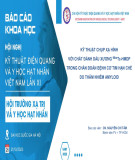

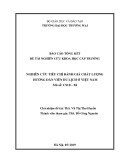
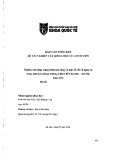
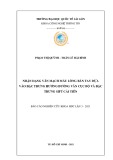

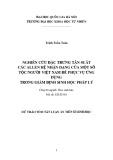
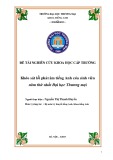
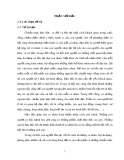
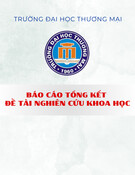




![Báo cáo seminar chuyên ngành Công nghệ hóa học và thực phẩm [Mới nhất]](https://cdn.tailieu.vn/images/document/thumbnail/2025/20250711/hienkelvinzoi@gmail.com/135x160/47051752458701.jpg)









